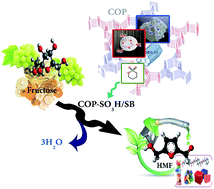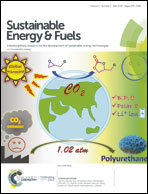A sulfonated triazine-based covalent organic polymer supported on a mesoporous material: a new and robust material for the production of 5-hydroxymethylfurfural†
Abstract
Herein, a triazine-based covalent organic polymer was grown on mesoporous SBA-15 through the condensation of melamine and cyanuric chloride. Then, the resulting composite was modified by sulfonic acid groups and used as a solid acid catalyst in the dehydration of carbohydrates to form 5-hydroxymethylfurfural (HMF). The catalyst was characterized by various techniques such as elemental analysis, FTIR spectroscopy, PXRD, TGA, BET, SEM, elemental mapping, and TEM. Moreover, the effect of different parameters, including reaction temperature, reaction time, catalyst amount, and solvent, was studied. The results indicated that under optimum conditions, a 78% HMF yield and a >99% conversion of fructose were obtained at 120 °C in 1 h. In addition, the HMF yield obtained from the dehydration of glucose was improved to 45% using COP-SO3H/SB under optimum reaction conditions. The reusability of the catalyst was investigated, and it was found that the catalyst could be regenerated and reused after four runs.



 Please wait while we load your content...
Please wait while we load your content...